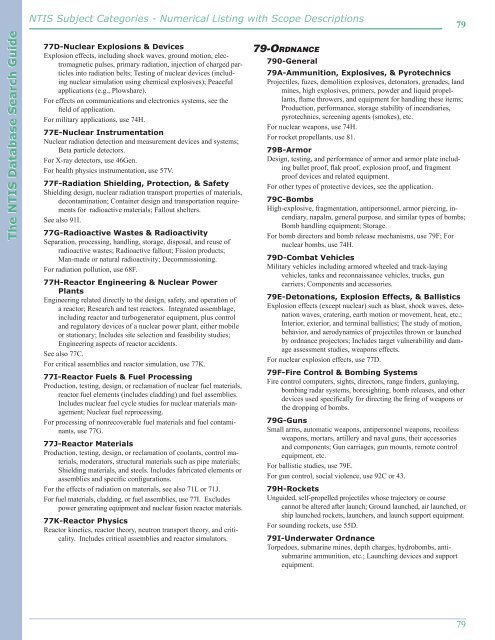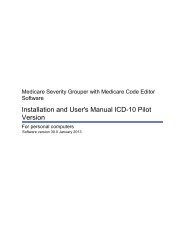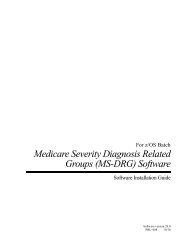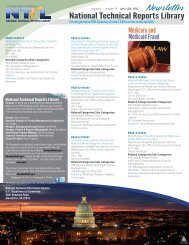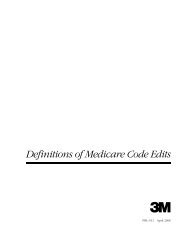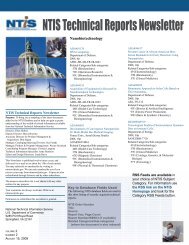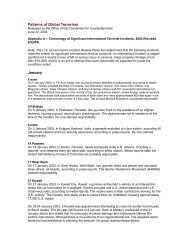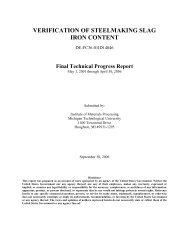DATABASE GUIDE - National Technical Information Service
DATABASE GUIDE - National Technical Information Service
DATABASE GUIDE - National Technical Information Service
Create successful ePaper yourself
Turn your PDF publications into a flip-book with our unique Google optimized e-Paper software.
NTIS Subject Categories - Numerical Listing with Scope Descriptions7977D‐Nuclear Explosions & DevicesExplosion effects, including shock waves, ground motion, electromagneticpulses, primary radiation, injection of charged particlesinto radiation belts; Testing of nuclear devices (includingnuclear simulation using chemical explosives); Peacefulapplications (e.g., Plowshare).For effects on communications and electronics systems, see thefield of application.For military applications, use 74H.77E‐Nuclear InstrumentationNuclear radiation detection and measurement devices and systems;Beta particle detectors.For X‐ray detectors, use 46Gen.For health physics instrumentation, use 57V.77F‐Radiation Shielding, Protection, & SafetyShielding design, nuclear radiation transport properties of materials,decontamination; Container design and transportation requirementsfor radioactive materials; Fallout shelters.See also 91I.77G‐Radioactive Wastes & RadioactivitySeparation, processing, handling, storage, disposal, and reuse ofradioactive wastes; Radioactive fallout; Fission products;Man‐made or natural radioactivity; Decommissioning.For radiation pollution, use 68F.77H‐Reactor Engineering & Nuclear PowerPlantsEngineering related directly to the design, safety, and operation ofa reactor; Research and test reactors. Integrated assemblage,including reactor and turbogenerator equipment, plus controland regulatory devices of a nuclear power plant, either mobileor stationary; Includes site selection and feasibility studies;Engineering aspects of reactor accidents.See also 77C.For critical assemblies and reactor simulation, use 77K.77I‐Reactor Fuels & Fuel ProcessingProduction, testing, design, or reclamation of nuclear fuel materials,reactor fuel elements (includes cladding) and fuel assemblies.Includes nuclear fuel cycle studies for nuclear materials management;Nuclear fuel reprocessing.For processing of nonrecoverable fuel materials and fuel contaminants,use 77G.77J‐Reactor MaterialsProduction, testing, design, or reclamation of coolants, control materials,moderators, structural materials such as pipe materials;Shielding materials, and steels. Includes fabricated elements orassemblies and specific configurations.For the effects of radiation on materials, see also 71L or 71J.For fuel materials, cladding, or fuel assemblies, use 77I. Excludespower generating equipment and nuclear fusion reactor materials.77K‐Reactor PhysicsReactor kinetics, reactor theory, neutron transport theory, and criticality.Includes critical assemblies and reactor simulators.79‐Ordnance790‐General79A‐Ammunition, Explosives, & PyrotechnicsProjectiles, fuzes, demolition explosives, detonators, grenades, landmines, high explosives, primers, powder and liquid propellants,flame throwers, and equipment for handling these items;Production, performance, storage stability of incendiaries,pyrotechnics, screening agents (smokes), etc.For nuclear weapons, use 74H.For rocket propellants, use 81.79B‐ArmorDesign, testing, and performance of armor and armor plate includingbullet proof, flak proof, explosion proof, and fragmentproof devices and related equipment.For other types of protective devices, see the application.79C‐BombsHigh‐explosive, fragmentation, antipersonnel, armor piercing, incendiary,napalm, general purpose, and similar types of bombs;Bomb handling equipment; Storage.For bomb directors and bomb release mechanisms, use 79F; Fornuclear bombs, use 74H.79D‐Combat VehiclesMilitary vehicles including armored wheeled and track‐layingvehicles, tanks and reconnaissance vehicles, trucks, guncarriers; Components and accessories.79E‐Detonations, Explosion Effects, & BallisticsExplosion effects (except nuclear) such as blast, shock waves, detonationwaves, cratering, earth motion or movement, heat, etc.;Interior, exterior, and terminal ballistics; The study of motion,behavior, and aerodynamics of projectiles thrown or launchedby ordnance projectors; Includes target vulnerability and damageassessment studies, weapons effects.For nuclear explosion effects, use 77D.79F‐Fire Control & Bombing SystemsFire control computers, sights, directors, range finders, gunlaying,bombing radar systems, boresighting, bomb releases, and otherdevices used specifically for directing the firing of weapons orthe dropping of bombs.79G‐GunsSmall arms, automatic weapons, antipersonnel weapons, recoilessweapons, mortars, artillery and naval guns, their accessoriesand components; Gun carriages, gun mounts, remote controlequipment, etc.For ballistic studies, use 79E.For gun control, social violence, use 92C or 43.79H‐RocketsUnguided, self‐propelled projectiles whose trajectory or coursecannot be altered after launch; Ground launched, air launched, orship launched rockets, launchers, and launch support equipment.For sounding rockets, use 55D.79I‐Underwater OrdnanceTorpedoes, submarine mines, depth charges, hydrobombs, antisubmarineammunition, etc.; Launching devices and supportequipment.79


